一般疑问句与否定句语法
- 格式:doc
- 大小:29.50 KB
- 文档页数:1
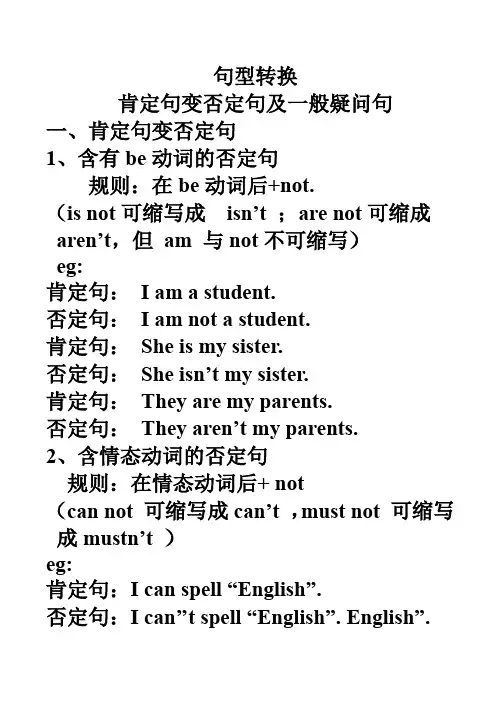
句型转换肯定句变否定句及一般疑问句一、肯定句变否定句1、含有be动词的否定句规则:在be动词后+not.(is not可缩写成isn’t ;are not可缩成aren’t,但am 与not不可缩写)eg:肯定句:I am a student.否定句:I am not a student.肯定句:She is my sister.否定句:She isn’t my sister.肯定句:They are my parents.否定句:They aren’t my parents.2、含情态动词的否定句规则:在情态动词后+ not(can not 可缩写成can’t ,must not 可缩写成mustn’t )eg:肯定句:I can spell “English”.否定句:I can’’t spell “English”.English”.肯定句:I must find it.否定句:I mustn’t find it.3、含有实义动词的句子的否定句构成(1)第三人称单数做主语。
(he、she、it或表示单个人或物的第三人称名词)规则:要在行为动词前加上助动词doesn’t,然后将动词恢复原形。
eg :肯定句:He has a soccer ball.否定句:He doesn’t have a soccer ball.(2)其它人称做主语规则:在行为动词前加don’t ,句子中的行为动词用原形。
eg:肯定句:They like bananas.否定句:They don’t like bananas.注:(1)在变否定句时,如遇some应变any Here are some books.Here aren’t any books.二、肯定句变一般疑问句1、含有be动词的句子变一般疑问句规则:把be动词提至句首,第一人称变第二人称,句末句号变问号。
(I/we变成youMy/our变成your)肯定句:I am a student.一般疑问句:Are you a student?肯定句:She is my sister.一般疑问句:Is she your sister?肯定句:They are my parents.一般疑问句:Are they your parents?2、含有情态动词的句子变一般疑问句规则:把情态动词提至句首,第一人称变第二人称,句末句号变问号。
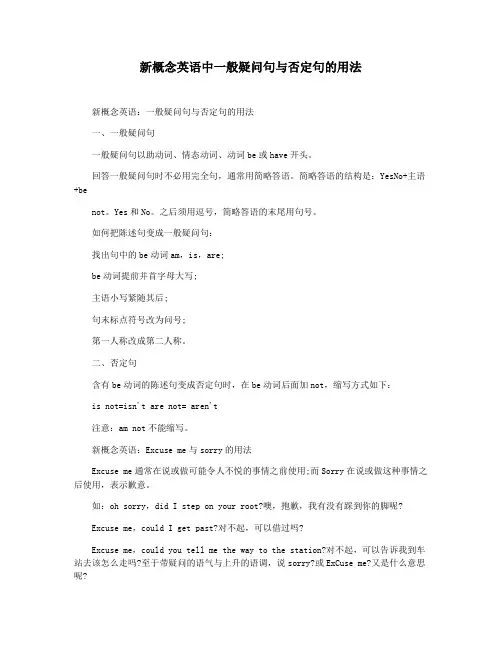
新概念英语中一般疑问句与否定句的用法新概念英语:一般疑问句与否定句的用法一、一般疑问句一般疑问句以助动词、情态动词、动词be或have开头。
回答一般疑问句时不必用完全句,通常用简略答语。
简略答语的结构是:YesNo+主语+benot。
Yes和No。
之后须用逗号,简略答语的末尾用句号。
如何把陈述句变成一般疑问句:找出句中的be动词am,is,are;be动词提前并首字母大写;主语小写紧随其后;句末标点符号改为问号;第一人称改成第二人称。
二、否定句含有be动词的陈述句变成否定句时,在be动词后面加not,缩写方式如下:is not=isn't are not= aren't注意:am not不能缩写。
新概念英语:Excuse me与sorry的用法Excuse me通常在说或做可能令人不悦的事情之前使用;而Sorry在说或做这种事情之后使用,表示歉意。
如:oh sorry,did I step on your root?噢,抱歉,我有没有踩到你的脚呢?Excuse me,could I get past?对不起,可以借过吗?Excuse me,could you tell me the way to the station?对不起,可以告诉我到车站去该怎么走吗?至于带疑问的语气与上升的语调,说sorry?或ExCuse me?又是什么意思呢?这样说那就不再是致歉的用语,而是听不清楚对方说什么,请求其再说一遍,如: A.It'the postman at the door邮递员在门口了。
B:Sorry?什么?A:I said it'sthe postman 我说是邮递员Excuse me是英语国家极为重要的礼貌用语。
在公共场合打喷嚏、咳嗽、打哈欠、打叫,甚至放屁都要对人说Excuse me。
但是有些亚洲学生却不知道这些,也没有养成这样的习惯。
有人打了一个喷嚏后,吸吸鼻子。

一般疑问句和否定句一般疑问句一般疑问句是疑问句的一种。
它是只用yes(是)或no(否)来回答的句子。
其结构是:be/助动词/情态动词+主语+其他成分。
第一人称变为第二人称。
通常回答为:肯定:Yes,主语+提问的be/助动词/情态动词.否定:No,主语+提问的be/助动词/情态动词的否定形式.1.先找be动词,置于句首,句末改成问号。
①It is a dog . (陈述句) Is it a dog ? Yes, it is. No,it isn’t.②They’re cakes. Are they cakes ? Yes, they are. No,they aren’t.③I’m a girl. Are you a girl ? Yes, I am. No, I’m not.2.没有be动词的情况。
①I like cars. (陈述句) Do you like cars ? Yes, I do. No, I don’t.②I have some apples. Do you have any apples? Yes, I do. No, I don’t.③I’d like some oranges. Would you like some oranges? Yes,please. No, thanks.④I can swim. Can you swim ? Yes, I can. No, I can’t.否定句①It is a dog . (陈述句) It isn’t a dog .②They’re cakes. They aren’t cakes.③I’m a girl. I’m not a girl.④I like cars. I don’t like cars.⑤I have some apples. I don’t have any apples.⑥I can swim. I can’t swim.习题1:1. It is my fridge . (改一般疑问句) _____________________________________2.They are our jackets. (改一般疑问句) _____________________________________3. They like mangoes. (改一般疑问句) _____________________________________4. I’d like some bananas. (改一般疑问句) _____________________________________5.We can skate. (改一般疑问句) _____________________________________习题2:①They are my skirts. (改否定句) _____________________________________②I like dolls. (改否定句) _____________________________________③It’s a cat. (改否定句) _____________________________________④You can skate . (改否定句) _____________________________________⑤We have some grapes. (改否定句) _____________________________________⑥I’m a boy. (改否定句) _____________________________________。
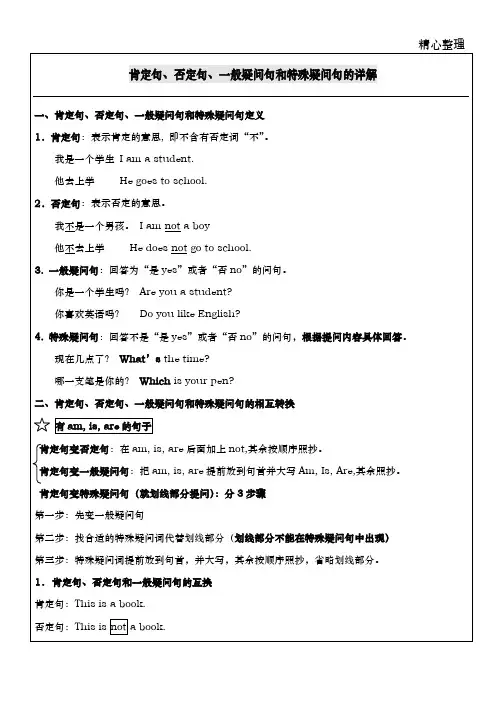
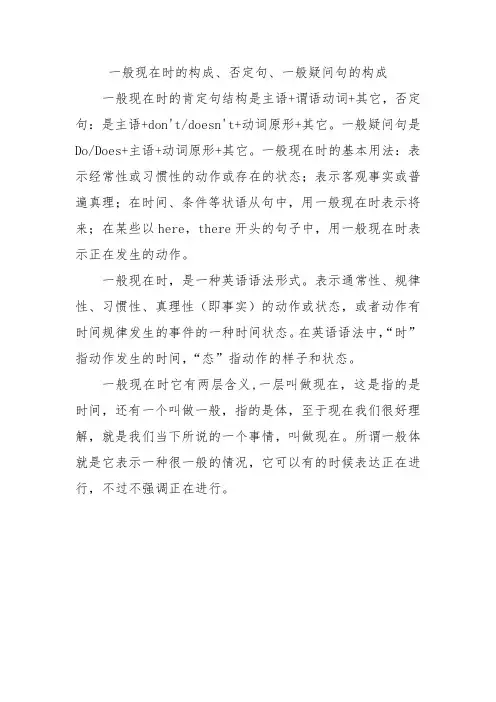
一般现在时的构成、否定句、一般疑问句的构成
一般现在时的肯定句结构是主语+谓语动词+其它,否定句:是主语+don't/doesn't+动词原形+其它。
一般疑问句是Do/Does+主语+动词原形+其它。
一般现在时的基本用法:表示经常性或习惯性的动作或存在的状态;表示客观事实或普遍真理;在时间、条件等状语从句中,用一般现在时表示将来;在某些以here,there开头的句子中,用一般现在时表示正在发生的动作。
一般现在时,是一种英语语法形式。
表示通常性、规律性、习惯性、真理性(即事实)的动作或状态,或者动作有时间规律发生的事件的一种时间状态。
在英语语法中,“时”指动作发生的时间,“态”指动作的样子和状态。
一般现在时它有两层含义,一层叫做现在,这是指的是时间,还有一个叫做一般,指的是体,至于现在我们很好理解,就是我们当下所说的一个事情,叫做现在。
所谓一般体就是它表示一种很一般的情况,它可以有的时候表达正在进行,不过不强调正在进行。
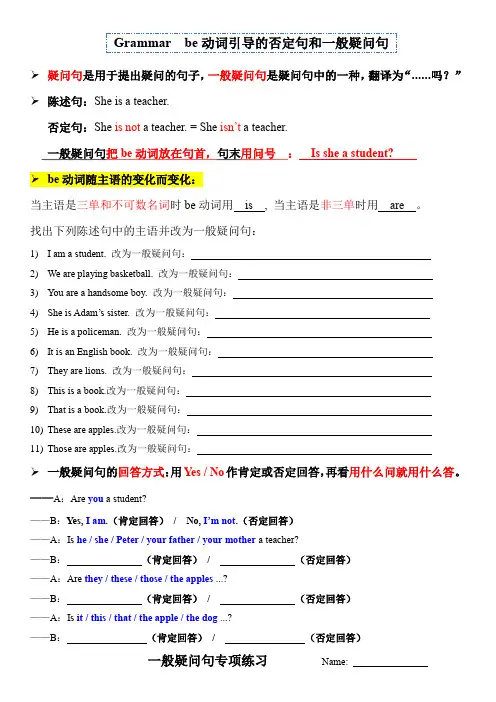
Grammar be动词引导的否定句和一般疑问句➢疑问句是用于提出疑问的句子,一般疑问句是疑问句中的一种,翻译为“......吗?”➢陈述句:She is a teacher.否定句:She is not a teacher. = She isn’t a teacher.➢be动词随主语的变化而变化:当主语是三单和不可数名词时be动词用is , 当主语是非三单时用are 。
找出下列陈述句中的主语并改为一般疑问句:1)I am a student. 改为一般疑问句:2)We are playing basketball. 改为一般疑问句:3)You are a handsome boy. 改为一般疑问句:4)She is Adam’s sister. 改为一般疑问句:5)He is a policeman. 改为一般疑问句:6)It is an English book. 改为一般疑问句:7)They are lions. 改为一般疑问句:8)This is a book.改为一般疑问句:9)That is a book.改为一般疑问句:10)These are apples.改为一般疑问句:11)Those are apples.改为一般疑问句:➢一般疑问句的回答方式:用Yes / No作肯定或否定回答,再看用什么问就用什么答。
——A:Are you a student?——B:Yes, I am.(肯定回答)/ No, I’m not.(否定回答)——A:Is he / she / Peter / your father / your mother a teacher?——B:(肯定回答)/ (否定回答)——A:Are they / these / those / the apples ...?——B:(肯定回答)/ (否定回答)——A:Is it / this / that / the apple / the dog ...?——B:(肯定回答)/ (否定回答)一般疑问句专项练习Name:一、将陈述句改为一般疑问句1.I am a pupil(小学生).2.Lily is an English teacher.3.This is your pen.4.Those are your books.5.These are my pens.二、对一般疑问句进行回答1.——Are you eight?——Yes, / No, 2.——Are they students?——/ 3.——Is that her pet?——/ 4.——Is he Fan Chengcheng?——/ 5.——Are those apples?——/ 6.——Is your mother a nurse?——/三、把下列陈述句改为否定句一般疑问句并做出回答1.This is our classroom.否定句:一般疑问句:肯定回答:否定回答:2.She is Miss Smith.否定句:一般疑问句:肯定回答:否定回答:3.I am in China.否定句:一般疑问句:肯定回答:否定回答:4.Miss Zhang is our English teacher.否定句:一般疑问句:肯定回答:否定回答:5.Tom is under the tree.否定句:一般疑问句:肯定回答:否定回答:6.Tom and Tim are good friends.否定句:一般疑问句:肯定回答:否定回答:。
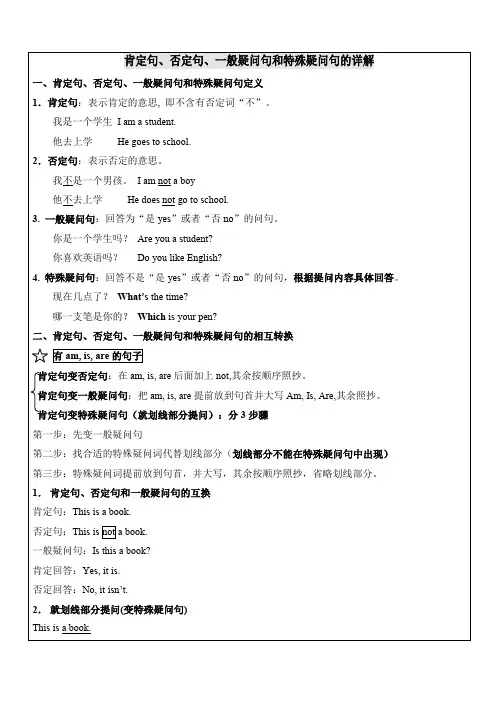
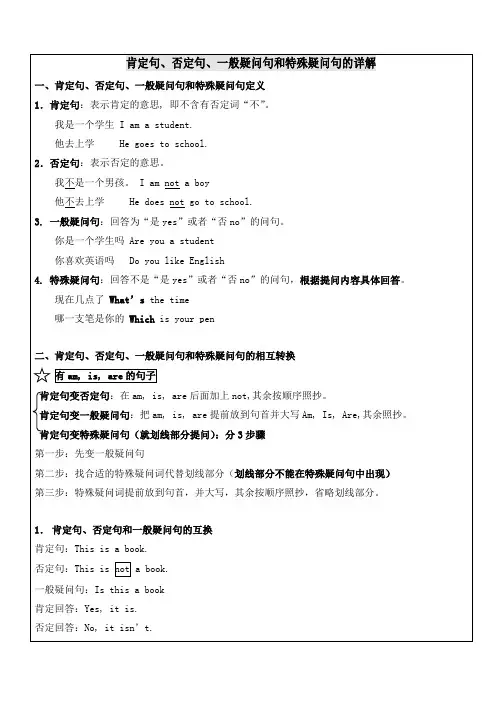

初中英语语法公式(7)疑问句,否定句Part1:公式法讲解 (1)Part2:否定句 (2)Part3:一般疑问句 (10)Part4:特殊疑问句 (14)Part1:公式法讲解变一般疑问句和否定句几乎是各类试题中句型转换部分的必考题目,变化公式为:“1找,2借,3做”。
1、找:(在谓语中找有无以下动词)be——am, is, are, was, were情态动词——can, should, will等助动词,如完成时态里的have 、has、had做“有”讲的have/has/had2、借:如果没有找到以上动词,而是一般的行为动词,则要根据时态和人称借用助动词do, does, did,同时要注意原行为动词的变化。
3、做:如果是变否定句,则在以上动词后加not如果是变一般疑问句或特殊疑问句,在将以上动词提到主语前。
举例如下:(关键动词用斜体标出)1)There are 5 apples on the table.一般疑问句:Are there 5 apples on the plate?否定句: There aren’t (are not) 5 apples on the plate.2)We can take him there.一般疑问句:Can we take him there?否定句: We can’t (cannot) take him there.3) Alice goes to school by bus.一般疑问句:Does Alice go to school by bus?否定句:Alice doesn’t (does not) go to school by bus.变一般疑问句和否定句的公式掌握了之后,只要举一反三,就得出变特殊疑问句的方法了,也就是在相应的疑问词后加一般问句语序即可。
如对“Alice goes to school by bus.”这句中的方式状语“by bus”提问,就是:How does Alice go to school?这里需要特别一提的是,以上“公式”适用于一般情况下变疑问句、否定句的题目,如果遇到特殊情况,如带有both/all的句子、祈使句等,则要个别特殊情况特殊处理。
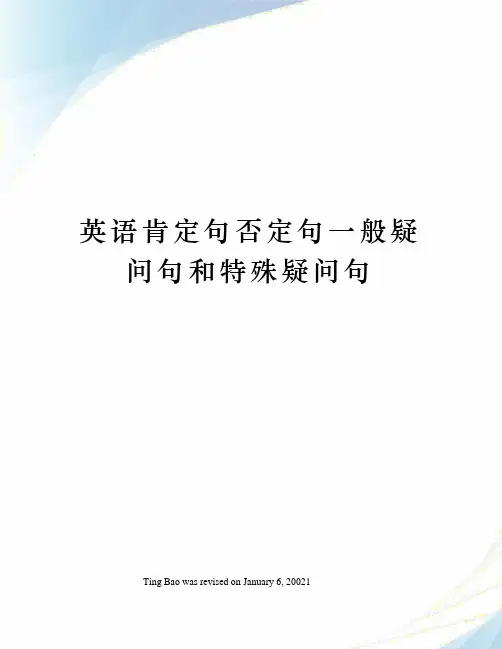
英语肯定句否定句一般疑问句和特殊疑问句Ting Bao was revised on January 6, 20021小学英语肯定句、否定句、一般疑问句和特殊疑问句一、be动词:am, is, are二、肯定句、否定句、一般疑问句和特殊疑问句定义1.肯定句:表示肯定的意思,即不含有否定词“不”。
比如:我是一个学生?I am a student.他去上学?He goes to school.2.否定句:表示否定的意思。
比如:我不是一个男孩。
I amnota boy他不去上学He doesnotgo to school.3.一般疑问句:回答为“是yes”或者“否no”的问句。
比如:你是一个学生吗Are you a student你喜欢英语吗Do you like English4.特殊疑问句:回答不是“是yes”或者“否no”的问句,根据提问内容具体回答。
比如:现在几点了?What’s the time?哪一支笔是你的Which is your pen三、肯定句、否定句、一般疑问句和特殊疑问句的相互转换有am, is, are的句子,肯定句变否定句:在am, is, are后面加上not,其余按顺序照抄。
肯定句变一般疑问句:把am, is, are提前放到句首并大写Am, Is, Are,其余照抄。
肯定句变特殊疑问句(就划线部分提问):分3步骤第一步:先变一般疑问句第二步:找合适的特殊疑问词代替划线部分第三步:特殊疑问词提前放到句首,并大写,其余按顺序照抄,省略划线部分。
注意:1.一定先变一般疑问句。
但是,如果问的是主语或主语的定语时,语序不变,为"特殊疑问词(+主语)+陈述句"。
如:Li ming's not here today. Who's not here today今天谁没来2.1.肯定句、否定句和一般疑问句的互换肯定句:This is a book.否定句:This isnota book.一般疑问句:Is this a book?肯定回答:Yes, it is.否定回答:No, it isn’t.2.就划线部分提问(变特殊疑问句)This is?a book.第一步:变一般疑问句Is thisa book第二步:找合适的特殊疑问词Is thiswhat第三步:特殊疑问词提前放到句首,并大写,其余按顺序照抄,省略划线部分。

小学英语肯定句、否定句、一般疑问句和特殊疑问句的详解一、be动词:am, is, are二、肯定句、否定句、一般疑问句和特殊疑问句定义1.肯定句:表示肯定的意思, 即不含有否定词“不”。
比如:我是一个学生 I am a student.他去上学 He goes to school.2.否定句:表示否定的意思。
比如:我不是一个男孩。
I am not a boy他不去上学 He does not go to school.3. 一般疑问句:回答为“是yes”或者“否no”的问句。
比如:你是一个学生吗? Are you a student?你喜欢英语吗? Do you like English?4. 特殊疑问句:回答不是“是yes”或者“否no”的问句,根据提问内容具体回答。
比如:现在几点了? What’s the time?哪一支笔是你的? Which is your pen?肯定句变否定句:在am, is, are后面加上not,其余按顺序照抄。
肯定句变一般疑问句:把am, is, are提前放到句首并大写Am, Is, Are,其余照抄。
肯定句变特殊疑问句(就划线部分提问):分3步骤第一步:先变一般疑问句第二步:找合适的特殊疑问词代替划线部分第三步:特殊疑问词提前放到句首,并大写,其余按顺序照抄,省略划线部分。
注意:1.如:Li ming 's not here today. Who's not here today? 今天谁没来?2.例如:1.肯定句、否定句和一般疑问句的互换肯定句:This is a book.否定句:一般疑问句:Is this a book?肯定回答:Yes, it is.否定回答:No, it isn’t.2.就划线部分提问(变特殊疑问句)This is a book.第一步:变一般疑问句 Is this a book?第二步:找合适的特殊疑问词 Is this what ?特殊疑问词提前放到句首,并大写,其余按顺序照抄,省略划线部分。
中考三年重点语法■初一部分三.句型变化•一般疑问句特殊疑问句否定句讲解与练习(―)疑问句疑问句分为一般疑问句和特殊疑问句。
一般疑问句:①句子中含有be动词和情态动词,则提前be动词和情态动词。
②句子中含有实义动词,在句子最前加助动词Do (复数)/Does (单数).③句子含有助动词,其他谓语动词用原型。
特殊疑问句:特殊疑问词+一般疑问句。
特殊疑问词:where/who/whose/when/which/what/whattime/what color/how/howsoon/how old/how long/how far/how oftcn/how many/how much .................(-)否定句否定句:①句子中含有be动词和情态动词,直接在be动词,情态动词后+not,缩写成n,t。
②句子中含有实义动词,在实义动词前+don,t (复数)/doesn,t(单数)。
练习1.一般疑问句1 .She's my sister (改为一般疑问句)____________ your sister?2.Are these your books?(作肯定回答)______, ____________ ・3.1s that her cup?(作否定回答)______, ____________ ,4.1'm Kate.(改为一般疑问句)____________ Kate?5.Are you in China?(作肯定回答)_____ J _______ •6.We often talk about our hobbies.(改为一般疑问句7.1like running and jumping.(改为一般疑问句) 8.She comes back home at 6 pm .(改为一般疑问句)9.Daniel has lots of homework,(改为一般疑问句)lO.Lily and I go to school on foot,(改为一般疑问句)1 l.We all have a good time today.(改为一般疑问句)12.His teacher always reads stories in class.(改为一般疑问句)13.1went to Nanjing with my brother last week.(改为一般疑问句)14.He always reads books before bedtime.(改为一般疑问句)15.My uncle teaches English in our school,(改为一般疑问句)16.Lily went to hospital to look after her grandfather last Sunday.(改为一般疑问句)17.Tim's brother seldom goes shopping with us.(改为一般疑问句)18.The little dog lost its way.(改为一般疑问句)19.We bought some gifts for our teachers.(改为一般疑问句)2O.They love going swimming very much,(改为一般疑问句)2l.His mum often brings nice sweets for us.(改为一般疑问句)22.Thc kite flics high in the sky,(改为一般疑问句)23.All of us saw that strange man in our school.(改为一般疑问句)24.Bob and I got the same points.(改为一般疑问句)25.1usually have breakfast at 7o'clock in the morning.(改为一般疑问句)26.She does her homework carefully.(改为一般疑问句)19.Can you sing ?(作否定回答)______ ,I ________20. Does he like speaking English?(作肯定回答) ___ ,he ____________21. Can Jane speak Chinese?(否定回答) ___ , ___________22. Is this boy your brother?(做肯定回答) ____ , _________23. Arc those her books?(做否定回答) ____ , ___________练习 2.Fill in the blanks with question words 用疑问词填空1. - ________ do you like Friday? -Because I have art and P.E.2. - _______ likes singing and dancing? -Lucy does.3. - _______ is your father's favorite sport? -Running.4. - _______ is your weekend? -It's great.5. - _______ is your School Day? -It's on October 28th.6. - _______ are you, Lingling? -I'm fine. Thank you very much.7. - _______ is your new iPad? -It is about 1,800 yuan.8. - _______ do you want to have for lunch? -I want to have some bread.9. - _______ is the girl in yellow? -She is nine years old.10. - ______ is your computer? -It is on the sofa.Write questions according to the answers 根据答语写出问句20. - _______ is this pair of pants? -It's 8() yuan.A. How manyB. How longC. How muchD. How often21. - _______ is the boy with a ball? -He is my brother.11, _________________________ 12. - ___________________________ 13. - ___________________________ 14. - ___________________________ 15. - ___________________________ 16. - ___________________________ 17. - ___________________________ 18. - ___________________________Single choice 单项选择19. - ________ your English books?A. Where'sB. Where are -My bag is under the chair.-My sister is only five.-My favorite star is Li Na.-Because I think red can make me lucky.-This pencil box is 5 yuan.-It's a book.-Chen Xiao's birthday is on July Sth, 1987.-My favorite subject is music. -On the sofa. C. What'sA. WhereB. WhatC. Who22.- _______ do you like history? -Because it is interesting.A. WhenB. HowC. WhereD. Why23.- _______ are the white hats? -They are on sale, only 15 yuan.A. How muchB. How oldC. How longD. How about Rewrite the sentences as required 按要求改写句子24.The pencil is blue.(对画线部分提问)________________ is the pencil?25.My pants are 15 dollars.(对画线部分提问)________________ are your pants?26.Li Hui is 13 years old.(对画线部分提问)________________ is Li Hui?27.That girl is my cousin.(对画线部分提问)that girl?28.My QQ number is 5067823426.(对画线部分提问)QQ number?29.1go to Beijing with my mother on Sunday.(对画线部分提问)you go to Beijing with your mother?练习3.否定句请将下列句子改为否定句1 .There is a computer on the desk.2. There are some pictures on the wall.3..She is seven years old.4.1like pears.5.She has a soccer ball.6.My mother wants to go to a movie.7.Tom can play the drums.8.1can sing and dance.9. She has some erasers.10.1think it is interesting.11.Mary plays sports after dinner.12.There lire, some tomatoes in the box.13.Tell him the news.14.She has brothers and sisters.15.1think she is right.16. She gets up at 6:00 in the morning.1.That is a ruler.2.This is an orange.3.She is my friend.4.Is that a pen?5.1like tomato.6.It's a dictionary.7.He has an English dictionary.8.She has a watch.9.This is a comedy and that is a. documentary.1(). There is a knife in the box.1 l.She is a girl student.12.She's a woman doctor.13.Who is your art teacher?14.1t's a bus.15.He usually goes to bed at 10:00.16.Gina doesn't play golf every da.y(改为肯句)17.Do you have tennis rackets?(改为肯定句)18 Jim doesn't have a bag.(肯定句)。
一般现在时定义:一般现在时:表示通常性、规律性、习惯性的状态或者动作(有时间规律发生的事件)的一种时间状态。
句子结构当主语是第三人称单数时:肯定句:主语+动词的第三人称单数+其他否定句:主语+doesn't+动词原形+其他一般疑问句:Does+主语+动词原形+其他肯定回答:Yes,主语+does否定回答:No,主语+doesn't特殊疑问句:特殊疑问词+一般疑问句当主语不是第三人称单数时:肯定句:主语+动词原形+其他否定句:主语+don't+动词原形+其他一般疑问句:Do+主语+动词原形+其他肯定回答:Yes,主语+do否定回答:No,主语+don't要注意,句式结构错则全局都错。
变化规律具体运用1.表示经常的或习惯性的动作,常与表示频率的时间状语连用。
时间状语: always, usually,regularly,everymorning/night/evening/day/week/year,often,sometimes,occasionally ,from time to time,twice a week,rarely,seldom,once a month, hardly, ever,never.e.g. I leave home for school at 7:00 every morning.2.表示主语具备的性格、能力、特征和状态。
e.g. I don't want so much.Ann Wang writes good English but does not speak well.比较:Now I put the sugar in the cup.I am doing my homework now.3.表示客观事实和普遍真理。
e.g The earth moves around the sun.Shanghai lies in the east of China.4.在时间状语从句和条件状语从句中,常用一般现在时代替将来时。
一般疑问句句型:1. 有be 动词的,直接把be动词提前至句首2. 无be动词的,(即只有行为动词的),借助助动词do/ does/ did 置于句首,句子中原来的动词用原型,句子顺序不变。
( do—用于现在时的第一人称单复数,第二人称单复数,第三人称复数,does 用于现在时的第三人称单数,did 用于过去时)例句:I am a worker. ------- Am I a worker?He is a student. ------ Is he a student?She was planting flowers in the garden.------ Was she planting flowers in the garden?Lily walked to the park yesterday.---- Did lily walk to the park yesterday?My mother washes the dishes everyday.--- Does your mother wash the dishes everyday?I ride a bike to the mountain with my friends every weekend.--- Do you ride a bike to the mountain with your friends every weekend?小练习:把句子变为一般疑问句1. Sarah is a friend of mine. ________ Sarah _______ _____ _____ ________?2. My father decided to buy me a computer. _______ your father _________ to buyyou a computer?3. He came to my home last night. ________ he _______ to _______ home lastnight?4. I have to finish my homework by nine. _______ you ______ to finish yourhomework by nine?5. She waters the flowers every eight hours. ________ she _______ the flowersevery eight hours?6. I slept well last night. _____ you ______ well last night?7. He is listening. ______ he __________?8. The rain lasted for two hours. _________ the rain _____ for two hours?9. I watched the football match yesterday with my friends._______ you _______ the football match yesterday with your friends?10. She just said hi to me. _______ she just ______ hi to you?11. My friend and I had a very long talk last night._______ your friend and you _______ a very long talk last night?12. I am reading in my father’s study._______ you reading in your father’s study?13. That girl over there is my sister. _______ that girl over there your sister?14. He always helps people. _______ he always _______people?15. Helen is at home. ______ Helen at home?16. He handed in his homework this morning._______ he _______in his homework this morning?陈述句肯定句变否定句:1. 有be 动词或情态动词的,直接在be动词和情态动词后加not,或者写成其缩写形式,如is not= isn’t are not= aren’t was not= wasn’t were not= weren’twill not = won’t can not= can’t should not= shouldn’t2. have 出现于完成时,直接在have 对应形式后加not,如have finished—have not finished= haven’t finishedhas finished—has not finished= hasn’t finishedhad finished—had not finished= hadn’t finishedhave 作实义动词时,借助助动词do/ does/ did,用法与3 一致、3. 句子中是行为动词做谓语的,变成否定句时借助助动词do/ does/did 于动词前,原动词用原型,如work—don’t work works—doesn’t work worked—didn’t work小练习:把句子变为否定句:1. I know these people. – I _______ ________ these people.2. Every new student will introduce themselves in front of the class.Every new student ________ ________ themselves in front of the class.3. He has decided to move to Beijing.—He _______ _________ to move to Beijing.4. I remembered that I had handed in the report this morning.I ________ _______ that I had handed in the report this morning.5. She dances for a living.—She ________ _________ for a living.6. Tom gave me a nice pen. – Tom ________ _______ me a nice pen.7. She made me a cup of coffee. – She _______ _______ me a cup of coffee.8. My mother bought me a pink skirt. – My mother _______ _______ me a pink skirt.9. I saw her chatting with Nancy. – I _______ _______ her chatting with Nancy.10. He invited us to come with him. – He _________ ________ us to come with him.11. There is going to be a heavy rain. – There _______ _________ to be a heavy rain.12. The ball is under the bed.—The ball _________ under the bed.13. I have a lot of money. – I ________ _______ a lot of money.14. Tom has decided to take the job. – Tom _______ ________ to take the job.15. Nancy has a lot of friends. – Nancy ______ ________ a lot of friends.16. Tim has a very friendly father. – Tim ________ ______ a very friendly father.17. I have been invited to the party. – I _______ _______ _______ to the party.18. She has lots of toys on her bed. – She ______ _______ lots of toys on her bed.19. They go to the zoo every Sunday. –They _______ _______ to the zoo every Sunday.20. Tom comes from America. He likes dogs but his dog died two years ago.Tom _______ ________ from America. He ________ _______ dogs and his dog ________ ________ two years ago.特殊疑问句***谨记疑问词意思What 什么when 什么时候where 哪里which 哪一个why 为什么How 怎么样who 谁whose 谁的how much/ how many 多少How long 多久(问持续时间时用)how often 多常(问频率时用)常用:What’s the time now?= What time is it now? 现在多少点?What day is it today? 今天星期几?What’s the date today? 今天几号?How is the weather?= What is the weather like? 天气怎么样?What is your father?= What does your father do? 你父亲是做什么的?(职业)句子顺序:1. 疑问词(what/ when/ where……) + be 动词+ 主语2. 疑问词(what/ when/ where……) + 助动词+ 主语+ 动词原形+…(句子剩下部分)3.疑问词whose/ which + 名词+ be 动词+主语或者whose/ which+ 名词+ 助动词+主语+ 动词原形4. how + 被修饰语+ be动词小练习:就划线部分提问1. This is a book. -- ________ ______ ______?2. I went to Paris last Saturday. - ________ _______ you ______ to Paris?3. I will wait for you at the gate. - _______ _____ you _______ for me?4. I like this one among the three best. - ________ one among the three ______ youlike the best?5. I got up late because I slept late last night. - _______ _______ you _____ up late?6. He did it in this way. - ______ _____ he ____ it?7. The ball is under the bed. - _________ _______ the ball?8. Li Lei is a doctor. - _______ is a doctor?9. This is mine football. ________ football ____ this?10. The river is five meters wide. - _____ ________ is the river?11. I want five kilos of pork. - _______ ______ pork _______ you want?12. I want five kilos of carrots. - __________ _______ carrots ______ you want?13. She is an office worker. - _______ _______ ______? / _______ ____ she _____?14. It was at nine last night that we went to the theatre.______ _______ you ______ to the theater last night?15. It’s five o’clock now. - _______ _____ the time now? /_____ time ___ ___ now?16. Today is July 1st. - _________ _______ the date today?17. Today is Sunday. - _______ ________ ________ _______ today?18. I go there in the morning. - _________ ______ you _____there?19. I visit my grandparents in the cottage twice a month. –________ _________ _______ you visit your grandparents?20. I will be away for two minutes. - ________ ________ will you _____away?21. Jim comes from England. - _________ _______ Jim ________ from?22. Miss Smith is her favorite teacher. - ________ ______ her favorite teacher?。
there is的否定句和一般疑问句在英语中,"there is" 是一个常用的存在句型,用于表示某物或某人的存在。
要将其转换为否定句和一般疑问句,我们需要使用一些特定的语法规则。
1. 否定句:要将"there is" 转换为否定句,我们需要在"is" 后面加上"not"。
例如:- There is a cat in the room.(房间里有一只猫。
)- There is not a cat in the room.(房间里没有猫。
)2. 一般疑问句:要将"there is" 转换为一般疑问句,我们需要将句子的主语和谓语调换位置,并在句首加上"Is"。
例如:- Is there a cat in the room?(房间里有一只猫吗?)- Is there not a cat in the room?(房间里没有猫吗?)以下是一些其他的例子:- There is a book on the table.(桌子上有一本书。
)- There is not a book on the table.(桌子上没有书。
)- Is there a book on the table?(桌子上有一本书吗?)- Is there not a book on the table?(桌子上没有书吗?)- There is a car in the garage.(车库里有一辆车。
)- There is not a car in the garage.(车库里没有车。
)- Is there a car in the garage?(车库里有一辆车吗?)- Is there not a car in the garage?(车库里没有车吗?)- There is a person at the door.(门口有一个人。
一般疑问句和否定句
班级__________ 姓名 ___________
一般疑问句
一般疑问句是疑问句的一种。
它是只用yes(是)或no(否)来回答的句子。
其结构是:
be/助动词/情态动词+主语+其他成分。
第一人称变为第二人称。
通常回答为:
肯定:Yes,主语+提问的be/助动词/情态动词.
否定:No,主语+提问的be/助动词/情态动词的否定形式.
1.先找be动词,置于句首,句末改成问号。
①It is a dog . (陈述句) Is it a dog ? Yes, it is. No,it isn’t.
②They’re cakes. Are they cakes ? Yes, they are. No,they aren’t.
③I’m a girl. Are you a girl ? Yes, I am. No, I’m not.
2.没有be动词的情况。
①I like cars. (陈述句) Do you like cars ? Yes, I do. No, I don’t.
②I have some apples. Do you have any apples? Yes, I do. No, I don’t.
③I’d like some oranges. Would you like some oranges? Yes,please. No, thanks.
④I can swim. Can you swim ? Yes, I can. No, I can’t.
否定句
①It is a dog . (陈述句) It isn’t a dog .
②They’re cakes. They aren’t cakes.
③I’m a girl. I’m not a girl.
④I like cars. I don’t like cars.
⑤I have some apples. I don’t have any apples.
⑥I can swim. I can’t swim.
习题1:
1. It is my fridge . (改一般疑问句) _____________________________________
2.They are our jackets. (改一般疑问句) _____________________________________
3. They like mangoes. (改一般疑问句) _____________________________________
4. I’d like some bananas. (改一般疑问句) _____________________________________
5.We can skate. (改一般疑问句) _____________________________________
习题2:
①They are my skirts. (改否定句) _____________________________________
②I like dolls. (改否定句) _____________________________________
③It’s a cat. (改否定句) _____________________________________
④You can skate . (改否定句) _____________________________________
⑤We have some grapes. (改否定句) _____________________________________
⑥I’m a boy. (改否定句) _____________________________________。